Just Beachy Golf Cart Rentals:
The Unforgettable Way to Enjoy Sullivans Island
Located 20 minutes from downtown Charleston, Sullivans Island is one of the most sought-after destinations in South Carolina for rest, relaxation, and rediscovery. Set in a stunning location of white sandy beaches, clean waters, and enchanting wildlife, Sullivans Island mixes all-natural vistas with the excitement of world-class recreation. With championship golfing opportunities, a thriving arts scene, spas, resorts, and award-winning restaurants, having fun on Sullivans Island is non-negotiable. When mixed with the sights and sounds of Mother Nature, Sullivans Island is the perfect place to unwind in an unforgettable setting.
At seven miles long and one mile wide, getting around Sullivans Island is uniquely fun. There's just one issue - what's the best way to get around such an idyllic island?
For most people, the answer to that question is super-convenient, super-fun golf cart rentals in Sullivans Island, SC, provided by Just Beachy Golf Cart Rentals. With the ability to drive 24 hours a day with no road restrictions, no other form of transportation will let you experience "the island life" quite like one of our street-legal golf carts.
In fact, with Just Beachy's golf cart rentals, you can zip from a sun-filled adventure on the beach to a restaurant with mouth-watering eats in just minutes. With a wide variety of golf carts and low-speed vehicles to choose from, finding fun, reliable transportation is easy as pie.
The Just Beachy Difference
At Just Beachy Golf Cart Rentals, we are committed to providing you with the best golf cart rentals in Sullivans Island, SC. Unlike some golf cart rental companies, who only see customers as numbers and transactions, our team wants your vacation to be fun and memorable. To facilitate that goal, we do everything in our power to make your golf cart rental experience easy and efficient.
Whether you choose to rent a luxury four-person golf cart in IOP's Wild Dunes Resort or a six-person golf cart in Sullivans Island, we've got you covered. Looking for a multi-day golf cart rental in Sullivan's Island? We've got a cart with your name on it.
At Just Beachy Golf Cart Rentals, you can rest easy knowing your vehicle is a high-quality cart. That's because we only use new models and premium options within our rental fleet. With some of the best cart rental prices on the island and no delivery fees, booking with Just Beachy is a no-brainer.
Need help figuring out where to start your adventure on the Sullivans Island? As full-time residents, our family is here to help during your stay if you have any questions or concerns. We know all the best spots for food, fun, and long days in the sun - simply send us a message, and we'd be happy to point you in the right direction. Because, at the end of the day, we're here to serve you as best we can - that way, you can make memories and see the islands from a vantage point you've never experienced before. Sullivans Island transportation is easy with Just Beachy golf carts.
Services Area
Our low-speed vehicles in Sullivans Island come with many standard features and advantages, including:
- Street Legal with No Driving Restrictions
- Four and Six Passenger Golf Cart Rental Options
- Premium Seating with Front-Facing and Rear-Facing Seats
- Long-Range Battery Options Available
- Safety Features Include Headlights, Taillights, Seatbelts, Turn Signals, and More

About Just Beachy Golf Cart Rentals in Sullivans Island, SC
Whether you're staying in Sullivans Island, Sullivan's Island, or Wild Dunes Resort, driving a golf cart or LSV is the best way to cruise around town. They're quick, efficient, and easy to use. Perhaps even more important is that our golf carts and LSVs are all electric.
As long-time residents, we prefer to keep Sullivans Island and the surrounding area clean and clear of smog. That way, our guests can disconnect and get back to nature without the rumbles and worries of gas-powered carts. After all - smelly, noisy gas carts can detract from the calm ambiance and amazing views that Sullivans Island is known to have.
Unlike gas carts, our electric carts are nearly noiseless and don't need gas to go. Our electric carts are also typically faster than gas options, making electric the faster, eco-friendlier choice when visiting Sullivans Island.
Our golf cart rentals on Sullivans Island, SC are:
- Convenient - Renting a golf cart is quick, easy, and the most convenient way to take in the sights and sounds of the Sullivans Island. Plus, you get direct access to local businesses and beaches without trying to maneuver a car or SUV.
- Local - When you rent a golf cart from Just Beachy, it's much easier to see and experience all there is to do on Sullivans Island. As an added bonus, you'll fit right in with the locals, many of whom will welcome you to the neighborhood.
- Fun - This is the best reason to rent with Just Beachy! Whether you're heading out for a long day at the beach or just need to run to the grocery store, nothing beats the feeling you get on an LSV or golf cart.
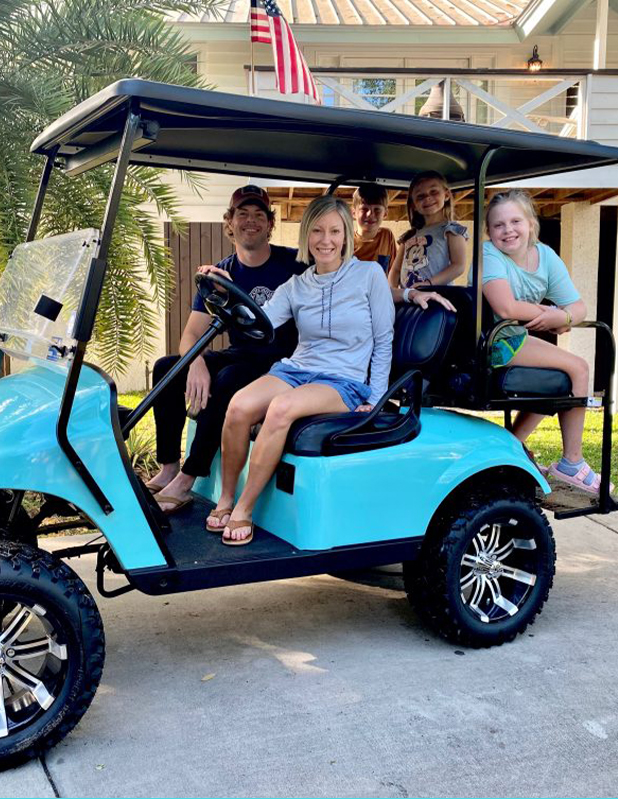
Benefits of Renting a Golf Cart or LSV On Sullivans Island
Utilizing a golf cart or LSV to travel around Sullivans Island isn't just fun - it also benefits your trip. Using a golf cart or LSV makes it much easier to access parking. That's especially true in our downtown district, where many parking spaces are metered. When it's time to enjoy one of the many restaurants on Sullivans Island, be sure to use the designated golf cart parking at Ocean Blvd and JC Long Blvd to avoid the hassles, headaches, and costs of traditional parking.
Just Beachy Golf Cart Rentals Pro Tip:
The Dinghy beach pub has a couple of designated golf cart spots within their parking area. If you decide to rent an LSV, you can also take it to Sullivans Island, which makes parking much easier.
When traveling North and South on the Sullivans Island, try to drive on Cameron Blvd and Hartnett Blvd when possible. Both options are less traveled than Palm or Waterway Blvd. and have a speed limit of 25 MPH. Waterway is a great option for traveling North and South, but you may run into more vehicular traffic. South of the Connector, try driving on Carolina Blvd or Ocean Blvd. Regardless of how you utilize them, an LSV or golf cart in Sullivans Island, SC, is super convenient and loads of fun during your stay.
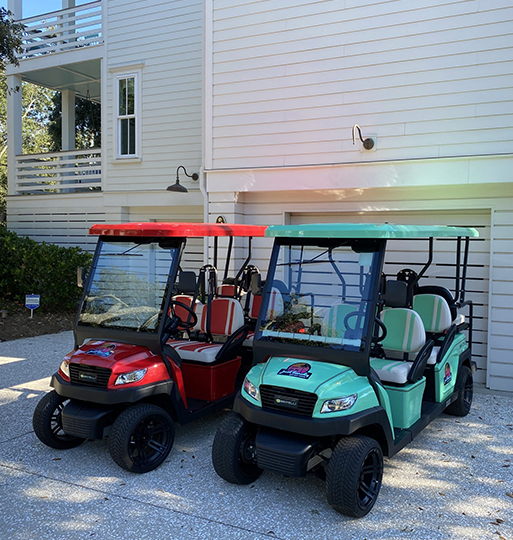
Benefits of Renting a Golf Cart or LSV On Sullivans Island
As is the case with Sullivans Island, choosing to rent a golf cart or LSV during your stay in Sullivans Island comes with many benefits. Like other areas, parking and getting around, in general, is just more manageable with a golf cart instead of a large car or SUV. If you rent a cart or LSV from Just Beachy but you're staying on Sullivans Island, you can bring your rental to the Sullivans Island and enjoy many of the same benefits.
Just Beachy Golf Cart Rentals Pro Tip:
If you plan on exploring the length of Sullivans Island, be sure to use Ion Ave and Atlantic Ave when possible. Both options are less traveled than Middle Street. They also have a speed limit of 25 MPH. Conversely, on Middle Street, the speed limit is 35 MPH. If you travel this road, you'll have to pull over so that faster cars can pass you. This can happen often and can ruin your otherwise enthralling drive. Regardless of how you use them or wear you take them, renting an LSV or golf cart on Sullivans Island is a great choice for everyone involved.
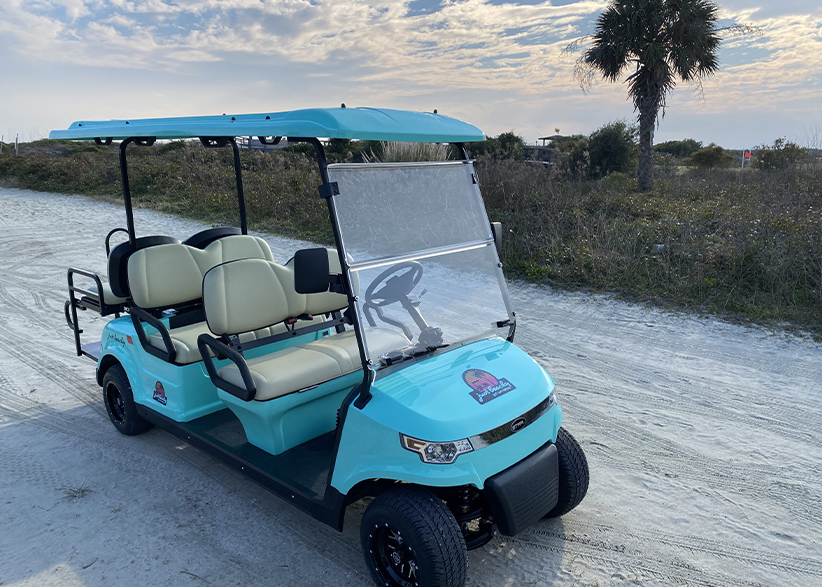
Benefits of Renting a Golf Cart or LSV On Sullivans Island
At Just Beachy Golf Cart Rentals, we want our guests to have the most fun, memorable experience possible when they visit. For that reason, it's important you keep these overall rental guidelines in mind.
- If you're the primary renter of one of our golf carts, you must be 25 years of age or older and have a valid driver's license to operate our carts.
- If any else will be driving a golf cart rental, they must be 21 years of age or older and have a valid driver's license.
- You must uphold and be compliant with all government regulations and laws when using a golf cart rental or LSV rental.
- You cannot have more people on your golf cart rental than the installed and designed seating capacity.
- Alcoholic drinks are not permitted in our LSVs or golf cart rentals. You may not operate any cart while under the influence.
- We only rent carts to single-family homes or townhomes. We do not rent to multi-story condos or hotels. Other locations inside Wild Dunes do not allow cart rentals. Additionally, regular golf cart rentals are not allowed in the Wild Dunes community. This area only permits street-legal LSV rentals.
The Best Places to Take Your Golf Cart Rental in Sullivans Island, SC
On the Sullivans Island, life is slower and simpler than the frantic pace found in nearby towns. So, if you're looking for a true beach vacation with few interruptions, Sullivans Island is the right place. With a fantastic coastal community, pristine beaches, and resorts, Sullivans Island boasts some of the best golf, fishing, sailing, and overall recreation on the east coast.
Of course, one of the Sullivans Island' key attractions isn't a roller coaster or concert venue - it's peace and quiet. Instead of jacked-up trucks and noisy supercars, this barrier island's laid-back atmosphere is embodied by golf cart rentals. In fact, many local attractions and establishments make special accommodations for golf cart renters, such as prime parking areas and discounts.
To help you make the most out of your visit, be sure to consider these popular places to take your Just Beachy golf cart rental.
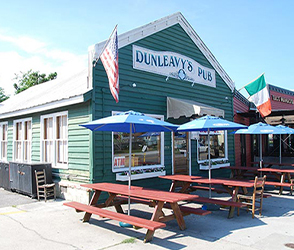
Beach Bars and Dives
Sullivans Island' beach bars and nightlife generally mimic what the island is known for: laid-back, beachy vibes with no worries in the world. Whether you're interested in a rooftop bar, a low-key dive, or something in between, it's easy to get around with golf cart rentals from Just Beachy.
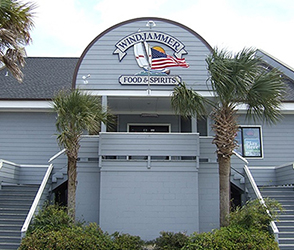
The Windjammer
Great for beachfront drinks and quick bites to eat, The Windjammer is an IOP staple that sits directly on the beach. If you're looking for a lively place to sit and spend time, this is the choice for you. As an added bonus, dogs are welcome at this bar, so after a walk or jog on the beach, relax with your furry friend at this popular location.

Coconut Joe's Beach Grill
This fun spot features a rooftop bar and fresh seafood for you and your friends to feast upon. Another staple of Sullivans Island, you can often catch live music and more on weekends throughout the year.
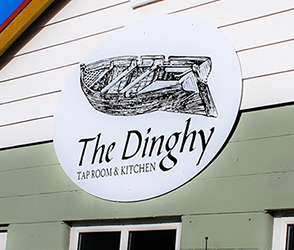
The Dinghy
You can't go bar hopping on IOP without swinging by The Dinghy. This longtime bar is known for its selection of craft brews on tap. With a giant screened-in porch, plenty of TVs, games, and happy hour events, The Dinghy has everything you need for a night out.

Restaurants and Eateries
After a long day at the beach with your friends and family, it's time to hop in one of our golf cart rentals in Sullivans Island, SC, and grab some food. After all, indulging in local cuisine is one of the best parts of being on vacation!
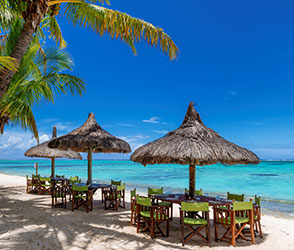
Long Island Cafe
A combo of coastal decor and an amazing food menu make this restaurant one you must try. Ask around, and locals will tell you the same thing - Long Island Cafe has been serving up fresh food since 1986. Try their specials and don't forget to satisfy your sweet tooth.
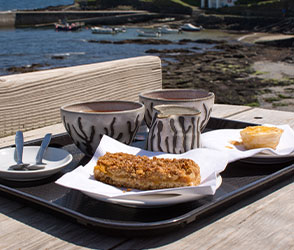
Sea Biscuit Cafe
If waking up early and getting breakfast is your preferred way to start the day, you've got to try the Sea Biscuit Cafe. This cash-only spot is ultra-popular and features everything from breakfast classics to Lowcountry exclusives. Fuel up and get ready for a fun day zipping around on your golf cart rental!
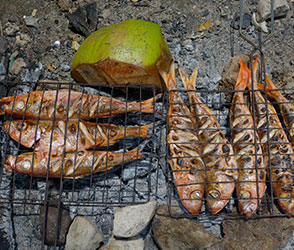
Coda Del Pesce
If you're looking to impress that special someone, this upscale restaurant is for you. With fresh-made Italian-inspired seafood dishes and an elegant ambiance, you'll need to book reservations well in advance of your trip to dine here.

Golf Courses
If you're a golf lover, you may never want to leave Sullivans Island once you discover its nearby golf courses. Sullivans Island is home to two world-renowned courses, both located in the resort community of Wild Dunes. This laid-back community is a fantastic place to stay during your visit and is very golf-cart friendly.
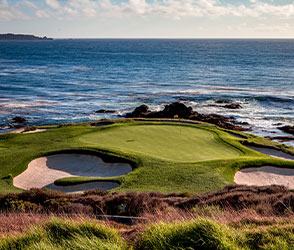
The Harbor Course
Designed by legendary golf course architect Tom Fazio, The Harbor mixes a challenging design with stunning sights and views. It's also known for its water features and includes salt marshes and lagoons, pushing the limits of your skills.
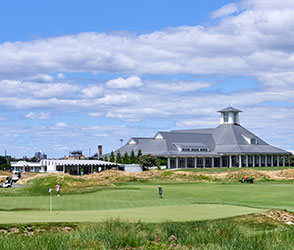
The Links Course
This course was Tom Fazio's first golf course design. It has stood the test of time with rolling fairways, rustling palms, and a finishing hole that overlooks the Atlantic Ocean.
Your First Choice for Golf Cart Rentals in Sullivans Island, SC
If you're searching for an unforgettable vacation in the prettiest of locations, thousands of visitors agree each year that the Sullivans Island is the place to go. From sun-filled days lounging by the beach to fine dining and everything in between, there's no shortage of new adventures to discover. And when it's time for new discoveries and unforgettable memories, renting an LSV or golf cart is the best way to get there.
Call or click today to learn more about Just Beachy Golf Cart Rentals or to get started booking your golf cart or LSV. We would be honored to serve you!
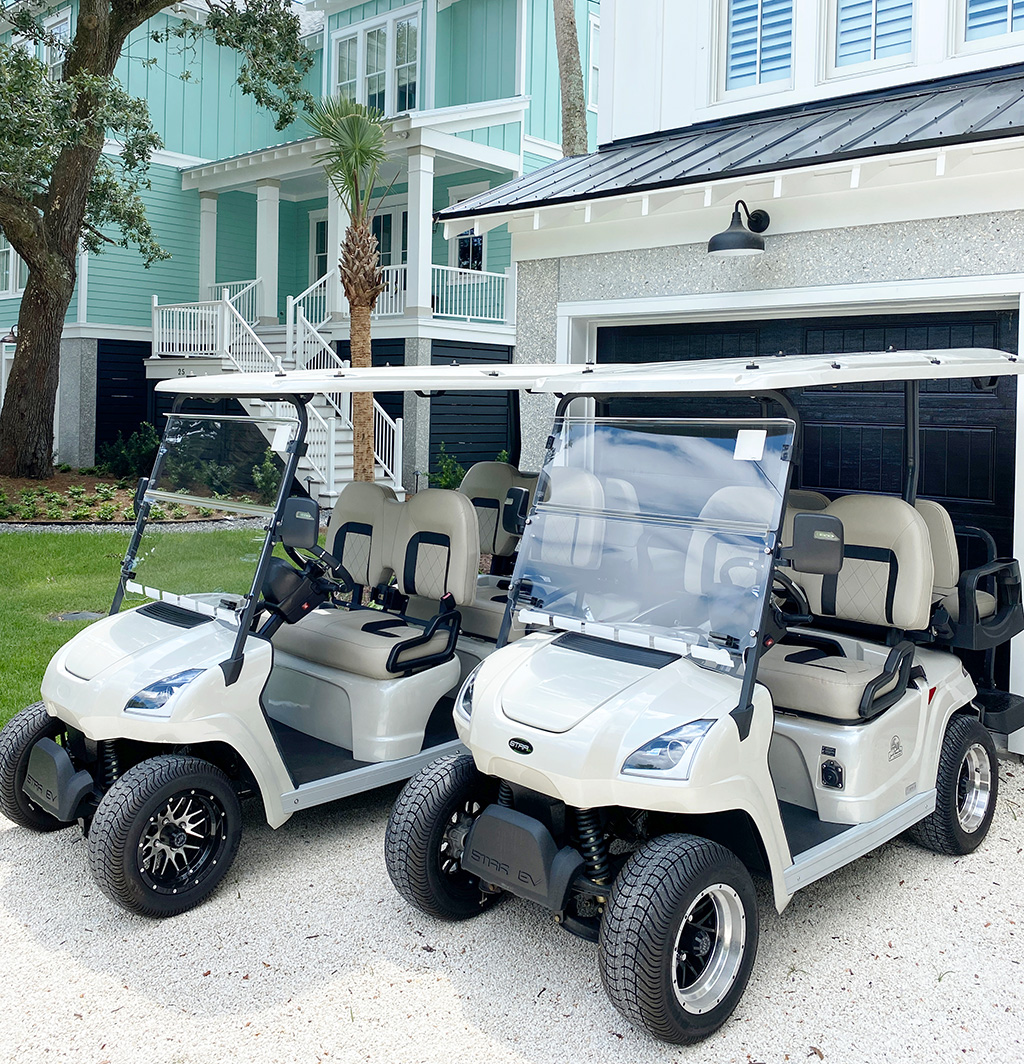
Latest News in Sullivans Island, SC
Letters: Private club is wrong for Sullivan's Island neighborhood
From Our Post and Courier Readershttps://www.postandcourier.com/opinion/letters_to_editor/letters-private-club-is-wrong-for-sullivans-island-neighborhood/article_fd4caccc-313e-11ee-9fec-47b0ced57fa0.html
I have lived on Sullivan’s Island since 1997.In a recent article about an exclusive club being proposed for the island, developer Shep Davis said, “The property operated as a private club for close to a century without being open to Island residents.”This is not true.When SCE&G owned the ...
I have lived on Sullivan’s Island since 1997.
In a recent article about an exclusive club being proposed for the island, developer Shep Davis said, “The property operated as a private club for close to a century without being open to Island residents.”
This is not true.
When SCE&G owned the Sand Dunes Club, island residents were allowed to buy passes to use the swimming pool for a very nominal fee.
The Sullivan’s Island Park Foundation held its annual fundraiser at the club. Innumerable residents used it for weddings, graduation parties, family reunions as well as bat and bar mitzvah parties.
The developers are requesting that Town Council change the zoning ordinances to allow for commercial use in a residential neighborhood.
This is a very slippery slope and a path Town Council must not take.
Single-family residential zoning has always been sacred on Sullivan’s Island, and separation between commercial and residential neighborhoods has always been maintained.
This is one of the things that makes our island special.
If an exclusive private club in the middle of a residential neighborhood is allowed on Sullivan’s Island, it could tear an irreparable hole in the fabric of our community.
PAT VOTAVA
Sullivan’s Island
Thanks for the recent, important editorial urging the S.C. Department of Transportation to improve safety conditions on King Street for people with wheels and pedestrians.
Speaking as a downtown resident without a car or bike, however, I am also concerned about the hazards of walking on Charleston’s many broken sidewalks.
I recently was dismayed to watch a young man in a wheelchair struggle to get past the broken sidewalk at 41 George St. near the College of Charleston. (I offered a push, but he declined and likely was embarrassed).
My husband fell a short time ago while trying to walk on the protruding and missing red bricks outside the college.
There are broken sidewalk pieces, and some sidewalks end in the middle of the block.
Is there any reason to allow safety cones to decorate a hole in the sidewalk for months at the corner of Meeting Street and Wragg Square?
Three months ago, I sent a list with photos of broken or unfinished sidewalks to the city authorities.
Two sites were fixed immediately on Calhoun Street in front of Gaillard Center (this was during Spoleto season), but most of the rest remain hazardous.
SHARON FRATEPIETRO
Charleston
Solomon Stevens’ commentary of July 30 said we have to resist the temptation to try to make our schools an extension of the moral or religious orientation of our homes. He wrote schools were never intended to be that and should not be that.
Yale University was founded as a Christian educational institution. In the book, “Sex and God at Yale,” author Nathan Harden chronicles the efforts of a secular president to replace that religious orientation with one based on raw secularism.
Among other things, he brought to the campus a lecturer who produced pornographic movies and claimed to have had sex with scores of women.
Things got so out of hand, the president was fired.
My point is that if Christians are not militant — in a nonviolent way — about what is being taught in schools, people who despise them and their beliefs will rush in to fill that vacuum.
When Thomas Jefferson wrote for “separation of church and state,” he did not write for separation of Christianity and state.
Mr. Stevens wrote our children need to learn how to think critically. That includes weighing and balancing competing arguments.
I agree. They need to balance 400 years of Christian teaching in this country with what has taken place in the non-Christian countries of the world.
Would we be better off today if our forefathers had embraced their religions and philosophies? Of course not.
I believe all public schools should teach the fundamental concepts of Christianity in order to provide the students with a basic understanding of the premise behind the many movements that have sharped our country.
Whether it was abolition, labor, civil rights or other movements, Christian principles have played a profound role.
Only after students understand this can they make intelligent judgments about competing arguments and how to confront complexities of the world around them.
GARY H. KNIGHT
Holly Hill
To submit a letter to the editor, send an email to letters@postandcourier.com or fill out the form on our online portal.
Letters can be a maximum of 250 words and are subject to editing for clarity, tone and libel. They must carry the writer’s name and address for publication and a daytime telephone number for verification.
Get a weekly recap of South Carolina opinion and analysis from The Post and Courier in your inbox on Monday evenings.
Sullivan's Island group urges protection of Maritime Forest
Lauren Lennonhttps://abcnews4.com/news/local/sullivans-island-group-urges-protection-of-maritime-forest-for-all-illegal-cutting-trees-vegetative-wall-storm-climate-change-land-charleston-county-south-carolina-sc-wciv
SULLIVAN'S ISLAND, S.C. (WCIV) — Sullivan's Island For All wants to make sure people know not only the beauty of the Maritime Forest, but also how it protects the community.Karen Byko, the president of Sullivan's Island For All, says the forest is more than just a home for wildlife.Read more: ...
SULLIVAN'S ISLAND, S.C. (WCIV) — Sullivan's Island For All wants to make sure people know not only the beauty of the Maritime Forest, but also how it protects the community.
Karen Byko, the president of Sullivan's Island For All, says the forest is more than just a home for wildlife.
Read more: Lowcountry law enforcement helps those in need at Seacoast Church
"The trees here are protecting us, so we need to protect them," she said. "The Maritime Forest provides a vegetative wall between the ocean and the homeowners, so that as storm surge comes in from the ocean, they provide that wall to protect us from that water. It's critically important that we preserve these trees to protect the island from that kind of destructive erosion."
Byko says there are some threats to this forest, such as the illegal cutting of the trees.
"We have people frequently who come out here and cut into public land trust, trees, and vegetation they do not own and they don't have a right to do," she said. "This land is protected for all of us to be able to enjoy."
According to Byko, everyone should care about this issue. She advocates for the protection of these 195 acres.
0 seconds of 0 secondsVolume 90%
Sullivan's Island For All wants to make sure people know not only the beauty of the Maritime Forest, but also how it protects the community. (WCIV)
"We live in a world where we know the effects of climate change are accelerating," Byko said. "We know these types of habitats are increasingly being destroyed and eroded. I just encourage everybody to come out here and know why we are fighting so hard to try to save this."
Byko also mentioned this forest is one of the last of its kind.
"There are very few places we can go to anymore that we can be in a wild space like this and be able to just enjoy it," Byko said. "If you look at maritime forests, you'll find there are very few that are left along the entire East Coast of the United States. This is one of the last few remaining Maritime Forests in the United States that's easily accessible to anybody."
"Anybody in Charleston can get in their car, drive over here, find a parking space, and enjoy the Maritime Forest," she said.
Barrier islands report up to 50 feet of beach erosion from weekend nor’easter
Anna Sharpe PChttps://www.postandcourier.com/environment/sea-island-beach-erosion-noreaster/article_7f3567ba-9ea9-11ee-a088-df85e3795e28.html
Giant swaths of sand were washed away on Charleston-area beaches as a result of this week’s nor’easter, officials reported. Folly Beach, the Isle of Palms, Sullivan’s Island and Kiawah Island — sites expected to be filled with tourists this summer — were especially hard hit.Folly Beach’s sand dunes were pushed back as much...
Giant swaths of sand were washed away on Charleston-area beaches as a result of this week’s nor’easter, officials reported. Folly Beach, the Isle of Palms, Sullivan’s Island and Kiawah Island — sites expected to be filled with tourists this summer — were especially hard hit.
Folly Beach’s sand dunes were pushed back as much as 20 feet. Kiawah Island reported up to 50 feet of erosion, with the highest erosion rates occurring around delicate Captain Sam’s Spit.
The Isle of Palms recorded beach erosion without providing specific measurements.
“We had a little bit of a buffer going into this thing that there’s really not much buffer left anywhere,” said Eric Lutz, director of public works on Folly Beach in discussing the tons of sand lost there.
He added that without the sand dunes that were there, damage on the island would have been worse.
Dunes offer protection from flooding and are meant to be “sacrificial,” he said.
“They’re doing what they’re supposed to do, but it is pretty catastrophic to the naked eye when you walk on the beach and see it,” Lutz added.
‘Greater than anticipated’
On Sullivan’s Island, a nearly 10-foot tide and churning waves battered the dunes and covered Thompson Park, the historic site of a Revolutionary War battle, washing away sand. Officials closed access to the park as a result.
“The dunes were beat up pretty bad by the high tide and the wave action, so we saw a loss of the dune in many areas on the beach,” Sullivan’s Island Town Administrator Andy Benke said.
As of the afternoon on Dec. 19, several roads on Sullivan’s Island remained flooded with standing water. The town’s stormwater infrastructure was overwhelmed by the heavy rainfall, Benke said, and it could take up to three days for the water in the streets to completely drain away.
COLUMBIA — Though it can sound counterintuitive at first, U.S. Forest Service specialists are going to set parts of South Carolina forests aflame to reduce the threat of fires.
Prescribed burns will be conducted throughout Francis Marion and Sumter National Forests over the next six months, officials with the U.S. Department of Agriculture said Feb. 8. The goal is to remove excess vegetation and dead wood from the natural habitat of plants and animals, which left unchecked could enable wildfires to spread wider, quicker and longer.
“Applying prescribed fire on the land at the right place, at the right time, under the right conditions, benefits the land,” U.S. Forest Service spokeswoman Pamela Baltimore said, adding that prescribed burning is “a critical management tool to improve plant and animal habitat and the resiliency of forest landscapes to withstand drought, insects and disease.”
Smoke is likely to appear in various parts of the forests while officials conduct the burns and could spread to nearby communities. Motorists are asked to use their low beams if they notice smoke on the road.
Forest Service fire specialists are planning prescribed burns on 50,000 acres in the Francis Marion National Forest in Charleston and Berkeley counties. Call the district office in Huger at 843-336-2200.
Burns are prescribed for 55,000 acres in Sumter National Forest, broken up into three ranger districts.
The first district’s fire specialists plans to conduct burns on 10,000 acres in Oconee County. Rangers with the second district will conduct burns on 20,000 acres in Chester, Fairfield, Laurens, Newberry and Union counties. The third district covers 25,000 acres across Edgefield, McCormick, Saluda, Abbeville and Greenville counties.
SCE&G's former seaside worker perk eyed for $30M-plus social club on Sullivan's Island
Warren L. Wise wwise@postandcourier.comhttps://www.postandcourier.com/business/real_estate/sce-gs-former-seaside-worker-perk-eyed-for-30m-plus-social-club-on-sullivans-island/article_a75c0c3c-353e-11ee-b1f4-5bb7ca099762.html
SULLIVAN'S ISLAND — A newly formed development group plans to invest more than $30 million to acquire and renovate a 90-year-old, vacant private oceanfront club on this seaside enclave.But elected officials want more details before signing off on allowing a commercial project in a residential area.Sulli...
SULLIVAN'S ISLAND — A newly formed development group plans to invest more than $30 million to acquire and renovate a 90-year-old, vacant private oceanfront club on this seaside enclave.
But elected officials want more details before signing off on allowing a commercial project in a residential area.
Sullivan's Island Bathing Co. is asking the town to allow a members-only social venture called the Ocean Club at 1735 Atlantic Ave. as a conditional use in an area zoned for single-family homes.
Shep Davis, the development firm's managing partner, pointed out last week that the property operated as a private club for close to a century without being open to island residents.
Under this latest proposal, they'll have that option for the first time — at a cost of a $60,000 sign-up fee and an estimated $500 in monthly dues.
The property had been known for decades as the Sand Dunes Club. It was a private beachside retreat for employees of the former South Carolina Electric & Gas Co., which Dominion Energy acquired in early 2019 after the V.C. Summer nuclear plant debacle 18 months earlier.
The Richmond, Va.-based utility closed the property at the onset of the COVID-19 pandemic in early 2020, and it never reopened, according to attorney Brian Hellman, a Sullivan's resident who is representing the development group.
Built in 1933 for $14,000, the then 5,400-square-foot structure was called Jasper Hall, an officer's club for military personnel stationed at nearby Fort Moultrie. SCE&G acquired it in the 1950s and expanded it over the years to just under 10,000 square feet.
Davis said the property has not been properly kept up for several years and is in disrepair.
One neighbor recently complained of the uncovered pool starting to smell and becoming a breeding ground for mosquitoes. Hellman and Davis said the pool is being maintained.
$30 million-plus
Davis estimated it will take an investment of "in excess of $30 million" for his group to buy the property, overhaul the building and amenities and place a stormwater retention pond underground. Retrofitting the pool alone, he said could cost half a million dollars.
Improvement plans include offering separate pools for families and adults, upgrading the existing building and landscaping the parking area. The developers also would add a fitness center, dining terrace and gazebo along with a new entry area off a beach access path.
"We can preserve the building and re-create the club for its historical use," Davis said.
Hellman said the current proposal comes after gathering input during several meetings with residents and town leaders over the past few months.
He said the private-membership venue will provide a place for homeowners to eat and exercise without having to drive off the island or jockey for tables with tourists at the restaurants in the town's small business district.
"It will be a gathering place to socialize that won't compete with beachgoers," Hellman said. "Dining will not be open to the general public and will reduce the need for residents to leave the island."
The 3.5-acre club site is owned by a company affiliated with Charleston real estate investor John Derbyshire, the former owner of the chain of Money Man Pawn shops. The firm paid Dominion $16.2 million for the property in 2022, according to Charleston County land records.
A large house is being built for Derbyshire, who plans to remain a partner in the project, on part of the property next to the club, according to Hellman.
Members matters
Get the best of the Post and Courier's Real Estate news, handpicked and delivered to your inbox each Saturday.
The developer said the goal is that the Ocean Club will be open to all Sullivan's residents who want to join. Davis estimated the venture will need at least 400 members to get the project off the ground.
The proposed Ocean Club would give priority to individuals and families who primarily reside on the island, said Jim Wanless, one of the partners. Off-island residents could join, too.
The proposed parking rules to allow a social club in a residential area require at least one parking space for every 10 memberships whose primary or secondary residences are within 2½ miles. Sixty percent of those spaces must be designated for golf carts and low-speed vehicles.
For members living outside the 2½-mile range, which is basically anyone who doesn't live on Sullivan's, one vehicle parking space would be required for every five memberships.
The rules also would require one bicycle space — through a rack or corral — for every 20 memberships.
"For whatever the number will be of those living off the island, they most certainly would come by car," Davis said. "On-island residents would have much less need for parking" since they'd have the option to come by golf cart, bike or foot.
Tentative plans call for 50 car parking spaces, at least an equal number of golf cart spaces and "adequate" bicycle parking spaces, Hellman said.
Though the membership will be open to all island residents, the developers don't expect everyone to join. They also have not set a cap on membership.
"We are trying to come up with the right number of members for the club without excluding property owners," Davis said.
Talking to the town
During a public workshop last week, where a standing-room-only crowd spilled into the hallway, the developers addressed a list of written questions from elected officials, including the benefit to the town if the club is allowed.
Davis said, under the current zoning, the property could be sold for residential development that would allow three to five homes that could be taxed at the 4 percent rate if they are primary residences. If the club use is allowed, the developers will pay the 6 percent commercial property tax as well as licensing and permit fees.
The developers also said they won't allow corporate memberships or agreements with hotels to provide dining or other services. In addition, no reciprocal-use deals with other private clubs are planned.
The projected hours of operation are 6 a.m. to 10 p.m. Sunday through Thursday for interior services, with the earliest morning hours set aside for fitness activities. The club would be open until midnight on Friday and Saturday. Outdoor activities would be allowed 6 a.m. to 10 p.m. each day except until 11 p.m. Friday and Saturday.
Some island residents see the idea as another amenity for Sullivan's while others are concerned about increased traffic and noise a club would bring to a residential area.
In letters to the town, supporters pointed to the property's long history as a site for dining, fitness, sports, recreation and cultural, educational and social events. They said those uses should continue to be allowed.
Others said they're against the rezoning to allow a restaurant or for it to become a for-profit entity.
Town Council is expected to discuss the issue further and take public input during its meeting Aug. 15. Mayor Patrick O'Neil cautioned the developers not to expect a quick decision.
"This council proceeds pretty deliberately," he said.
Our twice-weekly newsletter features all the business stories shaping Charleston and South Carolina. Get ahead with us - it's free.
Reach Warren L. Wise at wwise@postandcourier.com. Follow him on Twitter @warrenlancewise.
Sullivan’s Island Lighthouse a Last of its Kind: Beacon of the Beach
Mount Pleasant Magazinehttps://mountpleasantmagazine.com/2023/places/sullivans-island-lighthouse-last-of-its-kind-beacon-of-the-beach/
Every nightfall, a rotating light pulsates around Sullivan’s Island twice every 30 seconds. The luminous source is the Charleston Light, also referred to as the Sullivan’s Island Lighthouse, which has stood watch over the cozy beach town for more than six decades.When the pillar of light was first lit on June 15, 1962, it was recorded as the last major lighthouse in the United States built by the federal government. It was also the second brightest lighthouse in the Western Hemisphere, according to Fort Moultrie National H...
Every nightfall, a rotating light pulsates around Sullivan’s Island twice every 30 seconds. The luminous source is the Charleston Light, also referred to as the Sullivan’s Island Lighthouse, which has stood watch over the cozy beach town for more than six decades.
When the pillar of light was first lit on June 15, 1962, it was recorded as the last major lighthouse in the United States built by the federal government. It was also the second brightest lighthouse in the Western Hemisphere, according to Fort Moultrie National Historical Park guide Shelby McAllister.
The Charleston Light was erected to replace the defunct Morris Island Light, which was rebuilt in the 1870s after being destroyed in the Civil War. The lighthouse was at risk of being destroyed again by erosion and was later decommissioned.
Standing at 162.5 feet tall, approaching vessels in the Charleston Harbor could see the flash of the Charleston Light’s 28-million candlepower beam from more than 50 miles offshore. Five years after its construction, its wattage was reduced to 1.2-million candlepower, but it is still visible more than 25 miles away.
Its bright light wasn’t the only thing that caught people’s eyes. Many residents felt the original red and white color scheme was an eyesore. As the sun bleached the red to orange, it was decided that a paint job was in order. Black and white was the popular choice, so the Charleston Light received a makeover.
Sixty-one years later, the mid-century monolithic structure serves as more of a nautical landmark than a navigational aid, but its maritime history is not lost at sea. It was a fixture of the U.S. Coast Guard Historic District that includes buildings dating back to 1894.
When the Coast Guard automated the lighthouse in 1975, it no longer needed a keeper. In 2008, the Coast Guard relinquished ownership to the National Park Service.
THE MAN BEHIND THE LIGHT
Architect Jack Graham’s creation was not only the last of its kind, but it was also one of a kind. His vision for the lighthouse lit up in his mind when he was a 25-year-old graduate of the University of Pennsylvania School of Architecture and a serviceman in the Coast Guard.
In Graham’s last month of active duty, a supervisor gave him a final assignment of designing a lighthouse. The Coast Guard was displeased with the previous drawings that made it resemble a World War I battleship signal tower. By the time Graham was finished, it looked like an air traffic control tower.
Unlike typical circular lighthouses, Graham’s design was triangular with steel girders for the framework and aluminum alloy for siding. He credited his modernist approach and design to his college professor Louis Kahn, an influential modern architect in the post-World War II era known for his monumental and brutalist style.
In September 1989, Graham’s work would be put to the test when Hurricane Hugo lashed the island as a Category 5. The lighthouse’s design was intended to withstand winds up to 125 miles per hour. Hugo brought winds of 160 miles per hour, and the lighthouse never faltered.
In 2009, on Graham’s 75th birthday, he was able to view his creation from the top as he rode in the elevator for the first time. He wasn’t aware that his design was used for the lighthouse until three years after it was built, when he was flipping through a boating magazine.
The lighthouse became eligible to be listed on the National Register as part of the structures in the Coast Guard Historic District in 2012. That same year marked the structure’s 50th anniversary, during which Graham was recognized for the first time with an official ceremony and a historical marker on site.
Before Graham’s passing in June 2022, his wife Martha, who lives in Maryland, wrote “The Charleston Light and The Adventures of Scoops the Seagull.” The children’s book is about the lighthouse, which her beloved husband nicknamed “Sulli.”
Graham’s story lives on in the annals of history and is rekindled every time the sun sinks down past the horizon on Sullivan’s Island. That’s when the lighthouse and Graham’s legacy truly come to life.
Today, the lighthouse stands as one of the most technologically advanced for its time. It is the only lighthouse in America that has both an elevator and air conditioning, according to McAllister.
Due to ongoing problems with the elevator, there are no plans to open the lighthouse to the public. Of the 15 historic lighthouses in the state, none are currently open to the public due mainly to structural issues, she noted.
“This is history that is slowly disappearing, but not many people realize that,” McAllister added.
The National Park Service celebrates National Lighthouse Day every August by opening the Sullivan’s Island Lighthouse grounds to the public. The last time the lighthouse was open for tours was 2018.
By Zach Giroux
Sullivan’s Island Fire Department Renovates Facility: Fire Station Facelift Charleston & Mount Pleasant, SC Retirement Living Options at Franke at Seaside Southern String Supply: Master of Their Craft
Disclaimer:


